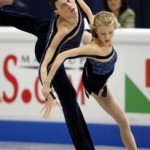Each week in The Moviegoer, Nick Olson examines new and upcoming films.
I stretch out my hands to you;
my soul thirsts for you like a parched land. [Psalm 143:6]
Blessed God, Israel’s God,
the one and only wonder-working God!
Blessed always his blazing glory!
All earth brims with his glory.
Yes and Yes and Yes. [Psalm 72. 18-20]
—
Near the beginning of Terrence Malick’s To the Wonder, there’s a scene in which Marina’s (Olga Kurylenko) young daughter, Tatiana (Tatiana Chiline), laments her lack of friends in the small suburban Oklahoma town. They moved to America after Marina fell in love with Neil (Ben Affleck), an American, in Paris. Marina feels her daughter’s acute sense of dislocation, too, but later, when she returns with her daughter to Paris for a brief time, she expresses that same sense of dislocation about her homeland. There’s much that could be said regarding the themes of dislocation in this film in the distinctly political sense–that is, as it relates Parisians in Texas, visas, and marriage-as-personal utility. But after Tatiana expresses her initial frustration, Malick cuts to an image of Neil in the yard, playfully spraying Marina and Tatiana with a garden hose. While she enjoys the playful moment, Tatiana is quickly shown reiterating her concern: “We need to leave. Both of us,” she says to her mother. “There’s something missing.” The scene then quickly cuts to one of Father Quintana’s (Javier Bardem) sermons, which populate the film in semi-regular intervals. He preaches, “There is love that is like a stream that goes dry . . . but there is love that is like a spring coming up from the earth. The first is human love, the second is divine love, and has its source above. The husband is to love the wife as Christ loved the church, and gives his life for her.”
While To the Wonder is even less a conventional narrative than The Tree of Life, it is no less a story. In fact, it’s a rather obvious story, even if it’s not delivered so obviously. It’s an image-driven narrative that unfolds via a montage of jump-cut impressions. So the beginning of the film features a compilation of wordless images depicting Neil and Marina falling in love in France, with particular attention paid to a trip they make to Mont Saint-Michel–“the Wonder of the western world.” Their flirtatious encounter reaches its height as they embrace atop the Benedictine abbey, overlooking the bay. Neil believes he’s at last found his true love; and Marina, a divorced mother of a ten year old girl who has been abandoned by the father, finds in Neil a kind of salvation. Cue Wagner.
And in a single shot, Normandy transitions into the sun-drenched plains of Oklahoma, where Neil and Marina eventually come down from their euphoric heights, trying to figure out what can ultimately bind and sustain them. Or in Neil’s case, whether he wants to be bound in commitment at all. What unfolds for the rest of the film are interweaving stories of characters–Marina, Neil, Father Quintana, and Neil’s hometown friend, Jane (Rachel McAdams)–experiencing some specific sense of spiritual dislocation, and struggling to find the kind of love that can anchor their exilic souls. Neil and Marina experience doubts about their relationship. Jane gets caught in Neil’s web of doubt and lust when Marina returns to France for a brief time. And Father Quintana has doubts about God’s presence in his life and ministry.
Given some of the claims bandied about in some Christian cultural criticism circles, I am always careful to avoid making unwarranted claims as it relates to whether or not a film is “Christian”–frankly, I’m not all that concerned with the way the faith is often tossed around in an adjectival manner, particularly in cultural criticism circles. Yet, I’ll go ahead and say this: I think To the Wonder is an essentially psalmic film. There are a few angles from which to consider Malick’s latest in this way, and this approach seems particularly justified, for as Michael Koresky notes, one of the unique qualities about To the Wonder as it is situated in Malick’s oeuvre, is that it features “a direct addressing of its characters’ specifically Christian faith rather than a vague outline of a nondenominational spirituality.” I would quibble with this a bit and suggest that the shape that spirituality takes in The Tree of Life, for instance, is not nearly as discernible without Christian theology. But Koresky’s certainly right in the sense that To the Wonder features Malick’s most overt depiction of his characters’ Christian faith.
With that backdrop in mind, then, I want to organize the sense that To the Wonder is psalmic around four thematic qualities that shape pslamic yearning: covenant, creation/fall, divine presence as holy site, and eschatological hope. Then, a fifth concern: the sense in which the film formally functions like a Psalm less in the scriptural sense than in the musical.
—
As a kind of hymnal for God’s people, the Psalms are full of praise and lament–songs that cover the range of experience of those who have entered into a covenant with God. This sense of covenant is at the forefront of To the Wonder not only in Father Quintana’s struggling relationship with, and commitment to, God, but in the marital starts and stops that beset the other characters. Part of Marina’s initial disorientation is that she’s already had a marriage abandoned. And so Neil’s covenantally uncommunicative behavior—exhibited to both Marina and Jane in different ways—leaves them alienated, sorrowful, and perplexed by his commitment to indecision. A sermon from Father Quintana, with the camera looming on Neil, confronts his mostly silent character: “We fear to choose. Jesus insists on choice. The one thing he condemns utterly is avoiding the choice. To choose is to commit yourself, and to commit yourself is to run the risk of failure, the risk of sin, the risk of betrayal. But Jesus can deal with all of those.” By contrast, Father Quintana doesn’t struggle with “burying his talents.” Rather, despite his struggle to feel God’s presence in his life as he once did, Father Quintana remains committed in spite of that felt absence, offering himself in service to the poor and the outcasts. So in the film, foregrounding the sense of yearning for divine love is the marital metaphor of Christ-church/husband-wife. Much of the film’s more sorrowful tone, then, derives from the explicit or felt absence of this loving covenant presence.
Additionally, To the Wonder continues Malick’s concern with the apparent duality of beauty and destruction in all things; this is the concern which gives shape to his cinematic approach. The Psalms are fundamentally concerned with the range of experiences and emotions evoked by the grand narrative of creation and fall. Of course, I don’t mean to ascribe a particular, orthodox doctrine of the Fall to Malick, but I think it’s true of many scenes in his films–which have so often been a mix of nature-as-sacrament and questions of theodicy–that part of what’s at stake is that something has gone wrong in the world around us. The reclusive director has cultivated a sacramental vision in his films that at once beholds the glory of creation, while also wondering about the corruption that has caused the degenerative spoil of the gifts of beauty, unity and other of love’s divine harmonies. Where is the Giver in all of this? Does he care? These are the questions which consume the interior lives of Malick’s characters, here particularly Father Quintana and his “dark night of the soul.” But also Marina, for instance, who echoes Jack’s plight from The Tree of Life when she laments a “cruel war” inside of her over whether she will be a woman who is “full of love.” This very sense in which we’re haunted by something that has gone wrong inspires a yearning for the gift of life despoiled, and for the Giver reconciled to us. This is another way in which we can describe this film as a psalmic yearning–of thirsting–for the fullness of divine presence: that all things might be “recreated,” or you might say, “born again.”
If it’s true that, essentially, humans are desiring beings–constituted in such a way so as to be oriented by love to something or someone–then here Malick’s characters are in search, knowingly and not, of the wonder-working God whose glories blaze the cosmos. This desire–this yearning–is such that to desire the inhabitance of God’s glorious presence is also to desire that one’s self might enter into and be filled with that glory. As such, we as individuals can ourselves become holy sites of worship in which God makes his loving presence known. At bottom, this yearning for divine presence is the search for a sanctuary in which boundary lines are marked out for the sacred. My Filmwell colleague, Michael Leary, has a review of the film up at Curator that will probably be one of my favorite pieces of film criticism this year. In his review, Leary has extended comments that draw connection between questions of theodicy and sacred/profane space, including this insightful line: “As a theodicy of the present, To the Wonder is a broken formal vessel through which glimmers the spatial and historic presence of God’s rightness despite the revelatory inadequacies of our inert storylines.” Indeed, through Lubezki’s lens, Malick becomes a kind of filmic psalmist, yearning for the distinctive presence of sanctified humans, times, and places. Malick is a psalmist in the sense that he depicts the intimate relationship between person and place, and how the ecological imagination is concerned with the sanctity of both.
Yet, like the Psalms, this yearning for the divine presence ultimately has an eschatological shape. The storied search that these characters find themselves in is a forward-moving one toward a glorious future. In the midst of his questioning of God–or, during the time when he acutely feels God’s absence–Father Quintana prays earnestly, “Where are you leading me? Teach us where to seek you.” Here, like Marina and Tatiana and Neil, Father Quintana feels sharply dislocated–and therefore disoriented. He suffers from a lack of hope which is eschatological in its shape in that it orients us to a reconciled future which is trusted to have already been established by the resurrected Christ. As such, the psalmic yearning for divine presence is a thirst for living water–for a future in which all things will be restored and renewed. Put differently, it’s the hope that the intermittent flickers of light which give flashes of hope to the long, dark night of humanity’s soul will become a refulgent beauty that eradicates the darkness. It’s therefore a hope that even the fragmented lives and relationships will eventually be made whole–that we will eventually find our dislocated selves finally located in the divine presence for which we yearn.
—
As in his other films–though here with even more of a dialogue-free, montage quality–Malick has Lubezki’s camera swooping around, looking for images of Edenic beauty; much has been made of this “abstract” approach, but I think Malick is in the process of trying to create a more musical cinema—an assertion that also fits my description of To the Wonder as psalmic. This seems obvious in the sense that the film operates in an especially expressive mode. But I want to push this a step further and suggest that the musical doesn’t just express emotions to the hearer, but, more than that, the musical shapes its hearer in a uniquely impressive way. Indeed, the Psalms are fundamentally formative. In an essay on The Tree of Life, I suggested that part of the reason Malick is operating in universal generalities as it relates to the specificity of his characters is that he seems to me to be pressing for us to awaken our own inner depths of subjectivity and inhabit the outlines he’s setting forth. He wants these grace notes to profoundly shape us—to impress upon us in the most personal way. And he seems to me to be pushing his film to have this power unto a musical quality.
Much as I’m on board with this approach, there were moments when this film felt to me too fragmented, struggling to evoke due to a lack of coherence that The Tree of Life seemed to achieve. There are moments—yes, involving twirling at magic hour, among other redundancies—in To the Wonder where the impression that is offered is so at odds with what I know as daily life that the dissonance is like a misplayed note amidst one of the most beautiful symphonies I’ve ever heard. Moments like this don’t just hurt my disbelief suspension because they’re not like life itself—it’s that they’re not even like a memory of a life. While I like To the Wonder more than Darren Hughes does, I think his concerns with the film are also the most incisive I’ve read as far as pans go. This passage in particular confirms some of my more cringing moments during the film:
I had hoped To the Wonder would be Malick’s marriage film or his sex film, but it’s neither, because Neil and Marina aren’t people. Not really. They’re beautiful avatars—models in an impressionistic fashion show far removed from the mundane realities of relationships. Like the “dance” between Neil and Jane in her pasture, Malick represents the most intimate moments between Neil and Marina in what are quickly becoming clichéd (if, admittedly, stunning) images: steadicam shots of them giggling, jumping on the bed, and play-wrestling in sun-washed, sheer-curtained bedrooms, and that ubiquitous shot of a beautiful woman moving away from the camera and then turning back toward it with a direct glance and a longing smile. The closest Malick comes to showing their sex life is a bit of chaste dryhumping with Affleck still in his jeans. We can only assume one or both of these characters have had an orgasm at some point in their relationship. That sort of thing is out of bounds for Malick.
There were moments when I felt like the characters had lost their humanity, and therefore the impressionistic approach of the film lost the power that I found so effective and coherent in The Tree of Life. The Psalms touch on genuine human experience and emotion. Jack opening and closing the door quietly as a punishment from his overbearing father, or kids chasing Chastain around the living room with a lizard are examples of deeply recognizable images in The Tree of Life. Even if you haven’t experienced these sort of memories yourself, they seem to me to resonate as if you had or might have experienced them; I don’t think To the Wonder once caused me to think about my relationship with my wife, and that, for me at least, bespeaks a problem given the film’s approach—even if I loved seeing Malick’s sacramental lens capturing contemporary life, populated by Skype and Sonic restaurants. Though present, it was at times too alien of a presence. As such, To the Wonder doesn’t quite evoke a kind of yearning in me in the way that did The Tree of Life.
Put differently, outstretched hands to the sky may be To the Wonder’s most psalmic image, and at times, its most cumbersome.
—
In the final minutes of the film, we hear a voice over from Father Quintana as we see images of Neil and Marina having what seem to be brief moments of reconciliation, and of the Father helping the disabled: “Christ be with me. Christ before me. Christ behind me. Christ in me. Christ beneath me. Christ above me. Christ on my right. Christ on my left. Christ in the heart. . . . Thirsting. . . . We thirst. . . . Flood our souls with your spirit and life . . . so completely that our lives may only be a reflection of you.”
I don’t think Malick has ever been so suggestive that our collective thirsting finds its living water source in Christ. We sing psalms because the Christian is in exile looking for home, crossing dry lands with signposts marked, “to the wonder.”











